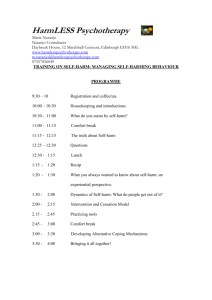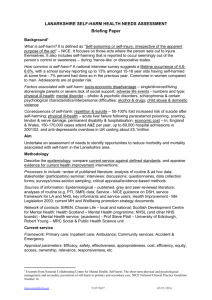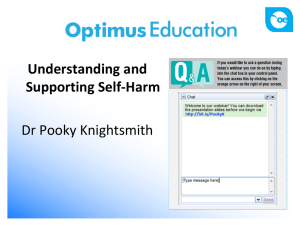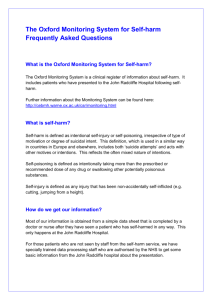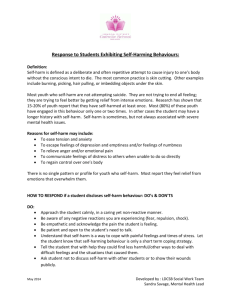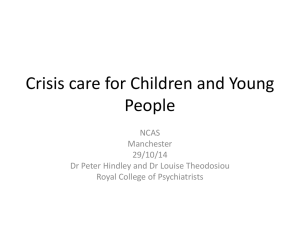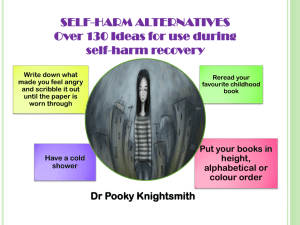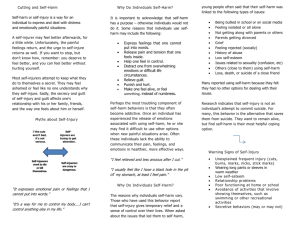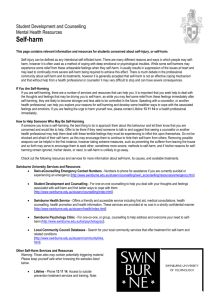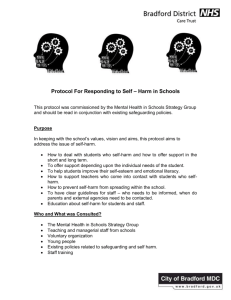Coping With Thoughts of Self-Harm
advertisement
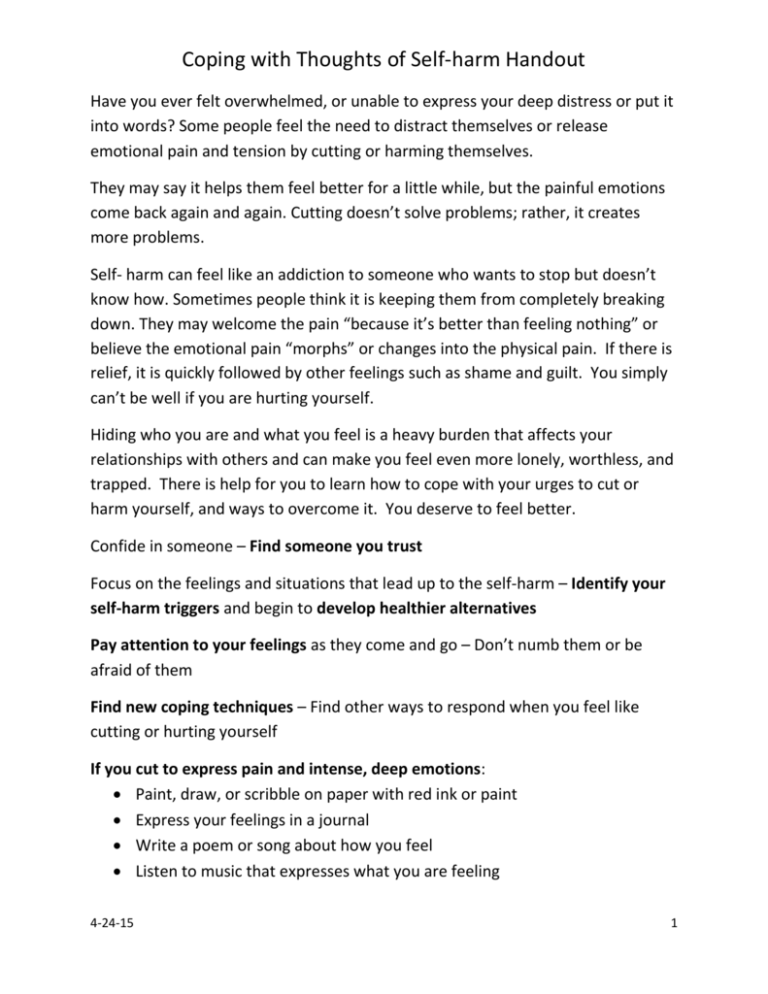
Coping with Thoughts of Self-harm Handout Have you ever felt overwhelmed, or unable to express your deep distress or put it into words? Some people feel the need to distract themselves or release emotional pain and tension by cutting or harming themselves. They may say it helps them feel better for a little while, but the painful emotions come back again and again. Cutting doesn’t solve problems; rather, it creates more problems. Self- harm can feel like an addiction to someone who wants to stop but doesn’t know how. Sometimes people think it is keeping them from completely breaking down. They may welcome the pain “because it’s better than feeling nothing” or believe the emotional pain “morphs” or changes into the physical pain. If there is relief, it is quickly followed by other feelings such as shame and guilt. You simply can’t be well if you are hurting yourself. Hiding who you are and what you feel is a heavy burden that affects your relationships with others and can make you feel even more lonely, worthless, and trapped. There is help for you to learn how to cope with your urges to cut or harm yourself, and ways to overcome it. You deserve to feel better. Confide in someone – Find someone you trust Focus on the feelings and situations that lead up to the self-harm – Identify your self-harm triggers and begin to develop healthier alternatives Pay attention to your feelings as they come and go – Don’t numb them or be afraid of them Find new coping techniques – Find other ways to respond when you feel like cutting or hurting yourself If you cut to express pain and intense, deep emotions: Paint, draw, or scribble on paper with red ink or paint Express your feelings in a journal Write a poem or song about how you feel Listen to music that expresses what you are feeling 4-24-15 1 Coping with Thoughts of Self-harm Handout If you cut to calm and soothe yourself: Take a bath or hot shower Pet or cuddle with a dog or cat Wrap yourself in a warm blanket Massage your neck, hands, and feet Listen to calming music If you cut because you feel disconnected and numb: Call a friend (you don’t have to talk about self-harm, but tell them how you feel) Take a cold shower Hold an ice cube in the crook of your arm or leg Chew something with a very strong taste, like chili peppers, peppermint, or a grapefruit peel Go online to a self-help website, chat room, or message board If you cut to release tension or vent anger: Exercise vigorously – run, dance, jump rope, or hit a punching bag Punch a cushion or mattress, or scream into a pillow Squeeze a stress ball, or squish Play-Doh or clay Rip something up (sheets of paper) Make some noise (play an instrument, bang on drums) Find a substitute for the cutting sensation: Use a red felt-tip pen to mark where you might usually cut Rub ice across your skin where you might usually cut Put rubber bands on wrists, arms, or legs and snap them Get professional treatment to overcome the self-harm habit: Talk to a therapist to get to the root of why you want to cut or hurt yourself Learn new coping skills to stop self-harming 4-24-15 2 Coping with Thoughts of Self-harm Handout Find out more about your resources: Call 211 if needed for crisis line or to get information about resources in your area S.A.F.E. Alternatives (Self-Abuse Finally Ends) is an organization dedicated to helping people who self-harm. It includes recovery information and a helpline: 1-800-366-2288 Smith, M. & Segal J. (2011). Cutting and self-harm: Self-injury help, support, and treatment. Retrieved 12-18-11 from http://www.helpguide.org/mental/self_injury.htm Are you ready to stop self-harm behaviors? Mark the statements that apply to you on this checklist - It isn't necessary that you be able to say "yes" to all of them, but the more of these things you can set up for yourself, the easier it will be to stop hurting yourself. o o o o o o o o o o I have a solid emotional support system of friends, family, and/or professionals that I can use if I feel like hurting myself. There are at least two people in my life that I can call if I want to hurt myself. I feel at least somewhat comfortable talking about self-harm I have a list of at least ten things I can do instead of hurting myself. I have a place to go if I need to leave my house so as not to hurt myself. I feel confident that I could get rid of all the things that I might be likely to use to hurt myself. I have told at least two other people that I am going to stop hurting myself. I am willing to feel uncomfortable, scared, and frustrated. I feel confident that I can endure thinking about hurting myself without having to actually do so. I want to stop hurting myself. Alderman T. (1997). Self-help: Organized and otherwise. Retrieved June 14, 2013 from http://www.selfharm.net/fself.html 4-24-15 3
